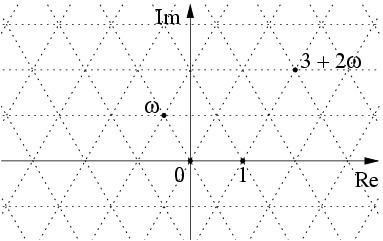 | ||
In mathematics, Eisenstein integers (named after Gotthold Eisenstein), also known as Eulerian integers (after Leonhard Euler), are complex numbers of the form
Contents
where a and b are integers and
is a primitive (non-real) cube root of unity. The Eisenstein integers form a triangular lattice in the complex plane, in contrast with the Gaussian integers, which form a square lattice in the complex plane.
Properties
The Eisenstein integers form a commutative ring of algebraic integers in the algebraic number field Q(ω) — the third cyclotomic field. To see that the Eisenstein integers are algebraic integers note that each z = a + bω is a root of the monic polynomial
In particular, ω satisfies the equation
The product of two Eisenstein integers
The norm of an Eisenstein integer is just the square of its modulus and is given by
Thus the norm of an Eisenstein integer is always an ordinary (rational) integer. Since
the norm of a nonzero Eisenstein integer is positive.
The group of units in the ring of Eisenstein integers is the cyclic group formed by the sixth roots of unity in the complex plane. Specifically, they are
{±1, ±ω, ±ω2}These are just the Eisenstein integers of norm one.
Eisenstein primes
If x and y are Eisenstein integers, we say that x divides y if there is some Eisenstein integer z such that y = zx.
This extends the notion of divisibility for ordinary integers. Therefore we may also extend the notion of primality; a non-unit Eisenstein integer x is said to be an Eisenstein prime if its only non-unit divisors are of the form ux where u is any of the six units.
It may be shown that an ordinary prime number (or rational prime) which is 3 or congruent to 1 mod 3 is of the form x2 − xy + y2 for some integers x, y and may therefore be factored into (x + ωy)(x + ω2y) and because of that it is not prime in the Eisenstein integers. Ordinary primes congruent to 2 mod 3 cannot be factored in this way and they are primes in the Eisenstein integers as well.
Every Eisenstein integer a + bω whose norm a2 − ab + b2 is a rational prime is an Eisenstein prime. In fact, every Eisenstein prime is of this form, or is a product of a unit and a rational prime congruent to 2 mod 3.
Euclidean domain
The ring of Eisenstein integers forms a Euclidean domain whose norm N is given by
This can be derived as follows:
Quotient of C by the Eisenstein integers
The quotient of the complex plane C by the lattice containing all Eisenstein integers is a complex torus of real dimension 2. This is one of two tori with maximal symmetry among all such complex tori. This torus can be obtained by identifying each of the three pairs of opposite edges of a regular hexagon. (The other maximally symmetric torus is the quotient of the complex plane by the additive lattice of Gaussian integers, and can be obtained by identifying each of the two pairs of opposite sides of a square fundamental domain, such as [0,1]×[0,1].)
